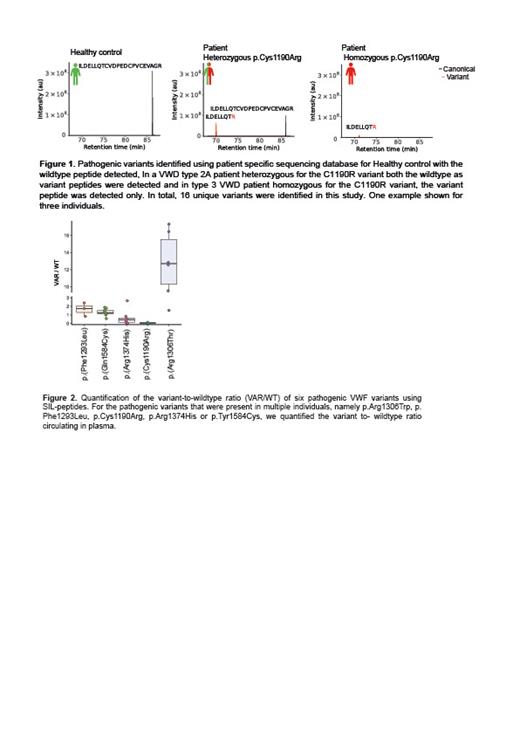Background:
Von Willebrand disease (VWD) is a commonly inherited bleeding disorder which is characterized by either low (type 1) or absent (type 3) levels of Von Willebrand factor (VWF) or by the occurrence of dysfunctional VWF proteoforms (type 2) in plasma. The complexity of diagnosing and managing VWD arises from limited understanding of the diverse VWF proteoforms present in both healthy individuals as well as in VWD patients.
Objective: The aim of this study was to investigate the plasma proteome and to characterize VWF proteoforms in Von Willebrand disease (VWD) patients, that were enrolled in the Willebrand in the Netherlands (WiN) 1 study, compared with healthy controls.
Method:
We selected type 1, type 2A, type 2M, type 2N and type 3 patients from the WiN cohort for which extensive laboratory- and genotype data were available. Plasma from 64 VWD patients and ten healthy controls was analyzed using a combination of discovery- and targeted mass spectrometry-based approaches.
Results:
Both discovery-based as well as targeted quantitative proteomics analysis revealed significant variation in VWF levels across the selected VWD patient group, which was in line with reported clinical laboratory data. Elevated VWF-propeptide/VWF ratios were observed in plasma samples from a range of VWD patients, with notable increases observed in VWD type 2A, B, and M, indicating accelerated clearance of these VWF proteoforms. Discovery-based proteomics revealed a strong VWF-F8 relationship in all VWD subtypes and healthy controls, except for type 2N VWD. We were able to identify peptides corresponding with common polymorphisms ( e.g. p.Thr798Ala, p.Gln852Arg, p.Thr1381Ala), for which the observed peptide distribution was in line with the minor allele frequency reported by the Broad institute. In addition, we identified peptides corresponding with 16 pathogenic VWF variants (e.g. p.Arg1306Trp, p. Phe1293Leu, p.Cys1190Arg, p.Arg1374His or p.Tyr1584Cys) of which p.Cys1190Arg wild-type and variant peptide aligned with the zygosity at DNA level (Figure X). Based on spike-in with stable isotope-labeled peptides, the variant-to-wildtype ratios varied among VWD patients with distinct pathogenic variants, ranging from 0.5-2.5 in type 2M (p.Phe1293Leu) and type 1 patients (p.Tyr1584Cys), <1 in type 2A patients (p.Arg1374His), to >8 in type 2B patients (p.Arg1306Trp), suggesting distinct stoichiometry of VWF variants among these patients (Figure 2).
Conclusion:
Our study highlights the feasibility of VWF proteoform identification and quantification from plasma and suggest a potential role in unravelling their contribution to the biological variations and clinical diversity observed in VWD.
1 De Wee et al., Determinants of bleeding phenotype in adult patients with moderate or severe von Willebrand disease. Thromb Haemost. 2012 Oct;108(4):683-92.
Disclosures
Leebeek:CSL Behring, Takeda, UniQure: Consultancy, Research Funding; Sobi: Research Funding; Roche: Membership on an entity's Board of Directors or advisory committees; Biomarin: Consultancy.


This feature is available to Subscribers Only
Sign In or Create an Account Close Modal